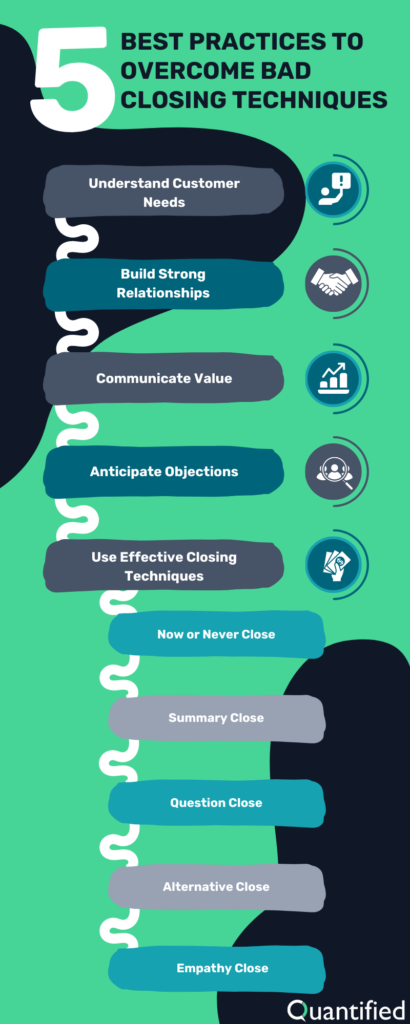Executive Summary:
Sales face numerous sales team challenges that can hinder performance and morale. Addressing these sales team challenges effectively can significantly boost productivity and team spirit. This blog will explore five common sales struggles and solutions to overcome them.
Addressing Common Sales Team Challenges
1. Biggest Sales Team Challenge: Closing Deals
Problem:
A high lead-to-close ratio is one of the common sales team challenges. Many leads may not progress beyond the initial contact, resulting in wasted time and effort.
Effects of Ineffective Closing Techniques:
Ineffective closing techniques in sales can lead to several problems:
- Lost Opportunities: When sales teams fail to effectively close deals, many potential sales are lost, resulting in missed revenue opportunities.
- Wasted Resources: Poor closing skills lead to prolonged sales cycles, which wastes time and resources that could be better spent on more promising leads.
- Low Conversion Rates: Ineffective closing can significantly lower conversion rates, impacting the overall performance and profitability of the sales team.
Best Practices to Overcome Ineffective Closing Techniques:
- Understand Customer Needs: Before closing a sale, it’s crucial to understand what your customer needs. Research their pain points and tailor your product or service to meet those needs. Knowing what motivates your customers helps you position your product as the best solution for their specific problems.
- Build Strong Relationships: Building trust and rapport with your prospects is essential. Customers are more likely to buy from someone they trust. This can be achieved by being genuine, showing empathy, and consistently providing value in your interactions.
- Communicate Value: Focus on value-based selling rather than just listing features. Clearly articulate how your product solves problems or improves situations for the customer. Highlight the unique benefits and demonstrate how your product will save them time, increase ROI, or reduce costs.
- Anticipate and Address Objections: Prepare for common objections and develop responses that address them effectively. Understanding and overcoming objections can bring you closer to closing the deal.
- Use Effective Closing Techniques:
- Now or Never Close: Create a sense of urgency by offering time-limited discounts or special offers to prompt immediate purchase decisions.
- Summary Close: Reiterate the benefits and value of the product to encourage prospects to sign the deal.
- Question Close: Ask probing questions to understand the prospect’s motives and guide them towards a decision.
- Alternative Close: Present multiple options to the prospect, helping them make a decision by highlighting the benefits of each option.
- Empathy Close: Show understanding of the prospect’s concerns to build trust and rapport, making it easier to close the sale.
- Leveraging Technology: Utilize CRM and sales enablement tools to track customer interactions and access updated information in real-time. Other AI-powered sales tools provide personalized coaching, sales simulations, and role-playing simulations. These tools help sales reps stay informed and prepared for closing discussions.
Example:
A company faced difficulties in closing deals due to challenges in handling tough conversations. By engaging in personalized coaching, they improved their ability to manage these conversations, leading to better sales outcomes and a higher close rate.
Benefit:
Effective closing techniques and improved follow-up processes can make a significant difference in converting leads into customers. By implementing these best practices and leveraging AI-powered tools, sales teams can enhance their closing skills, leading to increased sales and business growth.
2. Lack of Sales Alignment with Marketing
Problem:
A lack of alignment between sales and marketing teams is another significant sales team challenge that leads to disjointed messaging and missed opportunities. A common scenario illustrating this misalignment occurs when marketing teams report delivering numerous leads, while sales teams claim that none of these leads are qualified. This disparity often arises because marketing and sales define “qualified leads” differently.
Solution:
To bridge this gap, fostering collaboration between sales and marketing departments is crucial. Here are key strategies to achieve alignment:
- Define Shared Goals and KPIs: Establishing common objectives and key performance indicators (KPIs) ensures both teams work towards the same targets. For example, jointly defining what constitutes a marketing-qualified lead (MQL) and a sales-qualified lead (SQL) can help align expectations and improve lead quality.
- Regular Cross-Functional Meetings: Schedule consistent interdepartmental meetings to discuss progress, challenges, and strategies. These meetings should be used to review performance metrics, share feedback, and adjust tactics as needed. Weekly or monthly meetings help maintain open communication channels and ensure both teams stay aligned on goals.
- Collaborative Content Creation: Involve sales teams in the content creation process. Sales reps interact directly with customers and can provide valuable insights into the challenges and questions prospects face. This collaboration ensures that marketing content is relevant and useful for the sales process.
- Real-Time Data Sharing: Utilize technology to create a shared view of customer interactions. CRM systems and marketing automation tools can centralize data, allowing both teams to track customer journeys and engage prospects more effectively. Real-time dashboards and reports can help identify trends and adjust strategies promptly.
- Consistent Messaging: Ensure consistent messaging across all customer touchpoints. Sales and marketing should reinforce the same value propositions and brand promises. Regular updates and training sessions can help both teams stay informed about changes in strategy or messaging.
Example:
A nonprofit senior living provider aligned their sales and marketing efforts by integrating data from various platforms, enabling both teams to track performance metrics and collaborate effectively. The result was improved lead quality and conversion rates, demonstrating the power of aligned sales and marketing strategies.
Benefit:
Aligning sales and marketing teams leads to improved lead quality, better customer experiences, and higher conversion rates. This alignment fosters a cohesive strategy that drives revenue growth and enhances overall business performance.

3. Motivation and Morale
Problem:
Low motivation and morale are common sales team challenges that can significantly impact performance. Without clear goals and recognition, salespeople may feel undervalued and disengaged.
Solution:
Boosting motivation and morale involves several key strategies:
- Set Clear Goals: Establishing daily, weekly, and monthly goals provides direction and keeps the team focused. Setting SMART goals (Specific, Measurable, Achievable, Relevant, Time-bound) can help sales reps understand what is expected and how they can achieve it.
- Offer Incentives and Recognition: Recognize and reward achievements to motivate sales reps. Public recognition during team meetings or company-wide announcements can boost individual morale and inspire others to strive for similar success. Incentives such as bonuses, gift cards, or extra time off can also be highly effective.
- Build Trust: Developing trust within the team is fundamental. When sales reps trust their leadership, they are more likely to feel engaged and motivated. This can be achieved by being consistent, transparent, and supportive.
- Promote Teamwork: Encouraging a team environment where collaboration is valued over competition can enhance morale. This could involve team-building activities, shared goals, and peer mentoring programs.
- Provide Continuous Learning Opportunities: Offering ongoing training and development programs shows a commitment to the sales team’s growth. This could include product training, sales techniques, and industry updates. Encouraging continuous learning keeps the team engaged and prepared for new challenges.
Example:
Hubspot, effectively boosted its sales team’s morale by implementing several of these strategies. They provided access to a gym, healthy food, and a nap room to ensure their employees could maintain a balanced lifestyle. They also set various short-term and long-term goals, offered non-monetary rewards, and maintained a transparent feedback loop. These initiatives led to increased engagement and a significant improvement in sales performance.
Another example is Microsoft, which focused on building a strong culture of recognition and trust. They emphasized celebrating achievements and fostering a positive work environment, which resulted in improved team performance and morale.
Benefit:
A motivated sales team is likely to be engaged, productive, and successful in achieving their targets. By implementing these strategies, companies can enhance the overall performance and satisfaction of their sales teams.
4. Inadequate Sales Training and Development
Problem:
Inadequate training and development is one of the key sales team challenges that organizations often overlook. Relying solely on one-time training sessions can lead to poor retention of skills and a lack of continuous improvement.
Solution:
To address these issues effectively, encourage a comprehensive and strategic approach to sales training and development. Here are key strategies to overcome common training challenges:
- Customized Training Programs: Tailor training programs to meet the specific needs of your sales team. Avoid generic, off-the-shelf programs that don’t address the unique challenges your team faces. Customize the training content to align with your company’s approach to the market and the specific roles within your sales team.
- Blended Learning Approaches: Use a combination of in-person and online training to provide flexibility and ensure that training is accessible. This approach allows sales reps to learn at their own pace while still benefiting from face-to-face interactions when necessary. Incorporate internet-based learning platforms to enable reps to access training materials anytime, anywhere.
- Ongoing Training and Reinforcement: Implement ongoing training programs to reinforce learning and ensure skills are continuously honed. This can include regular refresher courses, advanced training sessions, and access to a library of resources for self-paced learning. Regular practice and follow-up are crucial to maintaining and improving skills over time.
- Interactive and Engaging Content: Utilize interactive elements such as role-playing, AI sales simulations, and gamification to make training more engaging and effective. These methods help improve retention by allowing reps to practice and apply new skills in a realistic context.
- Real-Time Coaching: Integrate real-time coaching to provide immediate feedback and guidance. On-the-spot training helps to reinforce learning and boost confidence.
Example:
A company offers a versatile platform that combines AI-driven real-time coaching, personalized training modules, and continuous learning opportunities. The platform’s interactive AI simulations make learning engaging and effective, while its real-time feedback helps reps improve their skills on the spot. This approach not only enhances skill-retention but also boosts overall sales performance.
Benefit:
Investing in structured, ongoing training programs ensures that sales teams are well-equipped to meet the demands of their roles and achieve better results. By focusing on continuous development and real-time support, organizations can foster a culture of learning and improvement, leading to sustained success.
5. Resistance to Embracing Technology
Problem:
Resistance to adopting new technology is another critical sales team challenge that can hinder efficiency and effectiveness. Technology can enhance sales efficiency and effectiveness, but some sales professionals resist adopting new tools and processes. Salespeople often resist new tools because they feel it is one more way for ‘Big Brother’ to watch them.
Solution:
Successfully rolling out new technology involves comprehensive training, support, and strategic involvement of the team. Here’s a structured approach:
- Find Out What Excites Your Team: Identify aspects of the technology that resonate most with your team. Incorporate these features prominently in your strategic rollout to build excitement and anticipation.
- Designate Top Performers as Champions: Select top performers to become technology champions. Giving them early access and allowing them to personalize the technology will create advocates who can build excitement among the team.
- Use Top Sellers’ Calls to Build Training: Utilize the best practices of your top performers to develop training programs. Personalize the training content to make it more relatable and effective.
- Comprehensive Training and Support: Offer extensive training to demonstrate how the technology simplifies workflows and enhances sales processes. Provide continuous support and clear documentation to ensure smooth adoption.
- Highlight Benefits: Clearly articulate how the technology benefits the sales team. Emphasize improvements in efficiency, better tracking of sales metrics, and ultimately, better results and compensation for the sales reps.
Example:
According to an article on IT Chronicles, successful technology rollouts involve key steps such as involving stakeholders early, developing a clear timeline, assigning roles, and maintaining consistent communication throughout the process. By following these steps, a company can ensure higher adoption rates and improved efficiency.
Best Practices for Rolling Out New Technology:
- Involve Key Stakeholders: Engage leaders and influencers within the sales team early in the process to gain their support and insights.
- Develop a Clear Rollout Plan: Break the rollout into manageable milestones and communicate the timeline to the team.
- Assign Roles and Responsibilities: Ensure everyone knows their part in the rollout to foster accountability.
- Document Everything: Keep detailed records of the rollout process to identify and address any issues quickly.
- Communicate Throughout the Process: Maintain open lines of communication to keep everyone informed and engaged.
- Create Small Successes: Recognize and celebrate early adopters and small wins to build momentum.
- Review and Adjust: Continuously review the process and make necessary adjustments based on feedback and performance metrics.
By following these steps and leveraging the right tools and expertise, you can overcome resistance to new technology and achieve higher adoption rates and improved efficiency.
Additional Tips for Sales Managers
- Regularly Review and Adjust Strategies: Continuously assess the effectiveness of your sales strategies and make necessary adjustments. Use analytics tools to gain insights and drive data-driven decisions.
- Foster a Culture of Continuous Improvement: Encourage your team to always strive for better performance. Provide regular feedback and create an environment where learning and development are prioritized.
- Leverage Peer Learning and Influence: Create opportunities for your team to learn from each other. Implement peer coaching and mentoring programs to share best practices and enhance skills collectively.
- Set Realistic and Achievable Goals: Ensure that your sales goals are challenging yet attainable. Use SMART (Specific, Measurable, Achievable, Relevant, Time-bound) criteria to set clear expectations and track progress.
- Recognize and Reward Performance: Acknowledge the hard work and achievements of your team. Implement recognition programs and offer incentives to motivate and retain top performers.
- Stay Updated with Industry Trends: Keep abreast of the latest trends and developments in your industry. Use this knowledge to refine your sales strategies and maintain a competitive edge.
Summary
Sales teams face numerous sales team challenges that can impact their performance and morale. However, by identifying these challenges and implementing targeted solutions, sales teams can improve their communication, close more deals, align better with marketing, boost motivation and morale, and embrace technology effectively. Leveraging comprehensive tools and training can help sales teams overcome these common struggles and achieve better results.
By following these strategies and leveraging the right AI tools and expertise, your sales team can overcome common challenges, achieve better results, and drive business growth. Start your journey towards a more efficient and effective sales team today.

- A View from the Top: What Pharma’s L&D Leaders Are Prioritizing (and What They’ve Left Behind)
- Behind the Training, Episode 4: Steve Muccini
- The Pharma Compliance Problem Nobody Talks About
- What Pharma Gets Wrong About AI Training
- Quantified Named to 2025 Inc. 5000, One of the 50 Fastest-Growing AI Firms in the U.S.
